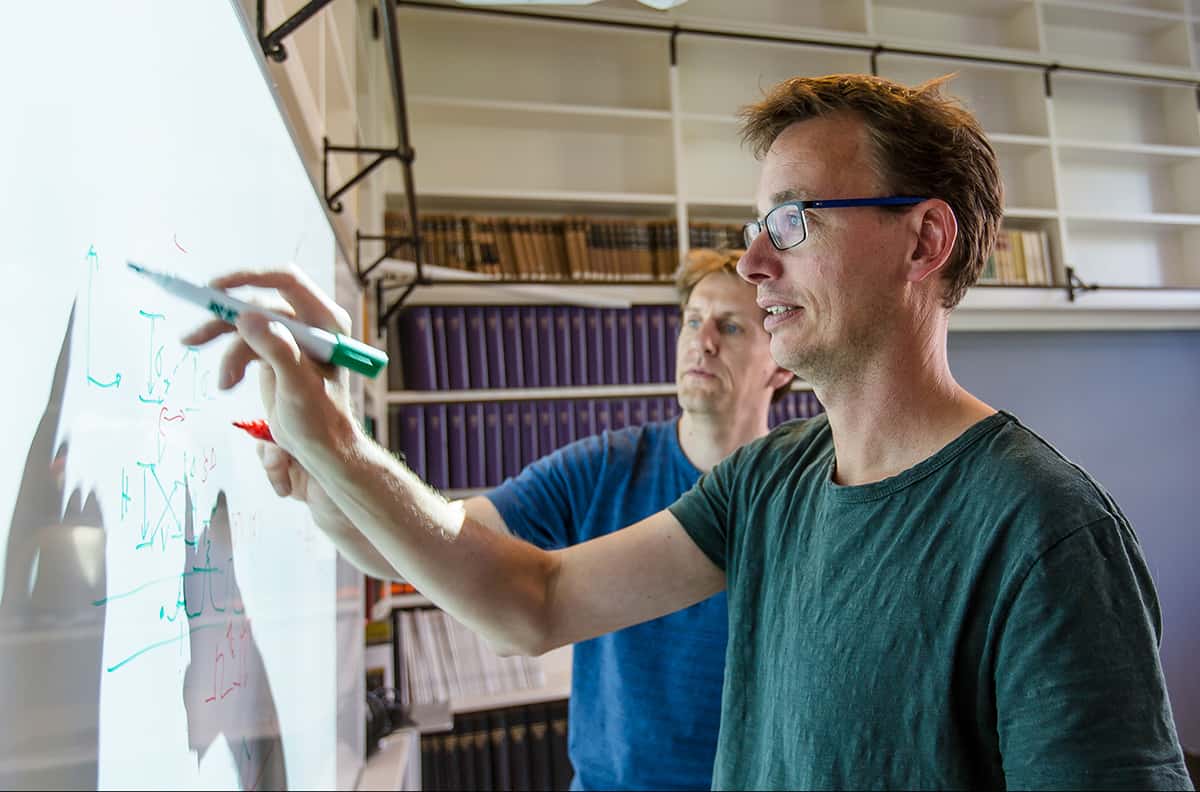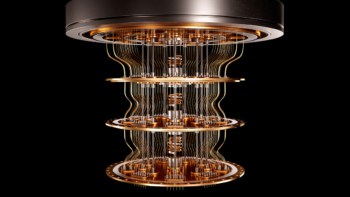What are the challenges and opportunities of processing and communicating quantum information over global networks? Joe McEntee talks to Peter Lodahl, who heads the Center for Hybrid Quantum Networks (Hy-Q) at the University of Copenhagen

What’s the headline goal at Hy-Q?
As part of the Niels Bohr Institute, Hy-Q comprises a talented and cross-disciplinary team of 50 researchers, working to deliver lasting value and impact in quantum science. Our aim is to create the foundational hardware and platform technologies for the quantum internet, exploiting the interplay between theoretical understanding, experimental systems, device design and fabrication – and pushing along all of these research pathways simultaneously. Operationally, Hy-Q prioritizes three discrete quantum platforms – photons, solid-state emitters and phonons – to enable remote connection, manipulation and storage of quantum information. Think hybrid quantum networks and a “best-of-all-worlds” approach that merges different quantum systems, each with its own pros and cons.
What’s possible as small-scale quantum systems evolve into large and complex quantum network architectures?
The Internet today distributes classical information over global length scales. The future quantum internet will transmit quantum information – single-photon qubits, say, or quantum entanglement – at the same global scale. This capability will, in turn, enable all sorts of unique applications, including quantum-encrypted communications for everything from governments and banks to healthcare providers and the military. Ultimately, we will see the implementation of at-scale parallel quantum computing resources, with remote computing nodes linked quantum mechanically across the network.
The transition from lab to field-deployable quantum technologies is already starting
Peter Lodahl, head of Hy-Q
Presumably it’s still early days for such network-level applications?
Correct, though it’s worth noting that the transition from lab to field-deployable quantum technologies is already starting. Late last year, for example, Hy-Q’s single-photon source technology was deployed as part of a successful field trial to demonstrate secure quantum key distribution (QKD) over an 18 km fibre-optic link on the existing telecoms network to our research partners at the Technical University of Denmark in Lyngby. This is the first time that on-demand single-photon sources have been applied in a real-world quantum communication link. As such, it’s an important first step in extending the technology to the ultimate security level known as “device independence”, where the quantum system is secure versus any hacking attempt, even on the apparatus used for encoding and decoding.
What technical challenges come into play when scaling up from lab-based quantum systems to quantum networks?
One of the biggest obstacles is optical attenuation on the installed fibre network. For starters, we’ll need robust quantum repeaters and quantum memories to send single-photon qubits beyond several hundred kilometres without losing them. Quantum repeaters are the equivalent of the fibre-optic amplifiers in today’s long-haul fibre-optic networks – essentially breaking the transmission link into discrete segments where optical losses are manageable and recoverable. The operational principle, though, is fundamentally different as amplification of quantum states is prohibited by the so-called “no cloning theorem”. But there’s a long way to go and the engineering challenges of these next-generation systems remain daunting.
How is Hy-Q tackling those issues?
Our scientists are exploring several ways to tackle the optical attenuation problem. A promising line of enquiry is what’s called the one-way quantum repeater. Rather than sending a single photon the entire distance, a cluster state consisting of multiple entangled photons – the cluster encoded with a single qubit of quantum information – is sent through a chain of repeater stations. At each repeater, the quantum information undergoes error correction and is transferred onto a “fresh” cluster state to counter the gradual photon loss versus distance. We are very good at producing entangled photons on-demand to evaluate such opportunities.

What about progress on quantum memories to store and convert quantum information across the network?
The Hy-Q optomechanics group, led by Albert Schliesser, is carrying out early-stage R&D on quantum memories – a must-have technology for any quantum communication or distributed quantum computing scheme. Specifically, the team’s focus is on ultracoherent mechanical devices – so-called phononic membrane resonators – which provide long coherence times (about 100 ms) while coupling efficiently to electromagnetic fields (from the radio-frequency to the optical domain, as well as electron and nuclear spins).

Turning a quantum advantage: IBM’s Jay Gambetta on seamlessly integrating quantum and classical computing
These resonators have a unique property – a bandgap that forbids the propagation of motion at certain frequencies. We can therefore “trap” a mechanical resonance in the phononic crystal, creating a well-isolated quantum system to store single single-photon qubits upon optical excitation. The opportunity is compelling: if we can reliably store photons generated with Hy-Q photon sources in the long-lived mechanical oscillations, we’d have a quantum memory that could store quantum information on timescales relevant for long-range quantum network applications.
Hy-Q brings together a wide range of expertise with an emphasis on openness and collaboration rather than competition
Peter Lodahl, head of Hy-Q
How would you pitch Hy-Q to a talented physics graduate considering options for PhD study?
I’m proud of the research culture at Hy-Q. This is a diverse team, bringing together a wide range of expertise to deliver success, plus there’s an emphasis on openness and collaboration rather than competition. That’s the magic: it’s not about who’s got the best CV or the longest publication list. Externally, we have long-standing collaborations with like-minded groups. For example, Arne Ludwig’s team at the University of Bochum, Germany, grows the highest-quality gallium-arsenide quantum-dot materials – the starting point for all our single-photon sources and photon-emitter interfaces at Hy-Q. We also work closely with Richard Warburton and colleagues at the University of Basel, Switzerland, sharing ideas in nanophotonics and semiconductor physics and with regular student exchange between our respective labs.
So the future’s bright for Hy-Q?
Absolutely. Our focus on the fundamental science of quantum networks is backed by the Danish National Research Foundation – we’re midway through a 10-year funding cycle – and that long-term support has enabled us to bring together world-leading expertise under one roof here in Copenhagen. Hy-Q is all about the long game: it’s going to take patience, cross-disciplinary collaboration and a relentless focus on continuous improvement to mix-and-match the enabling platform technologies for the quantum internet.
Translating quantum science into network-ready technologies

While Hy-Q’s efforts are skewed towards advances in fundamental quantum science, Peter Lodahl and colleagues are also eyeing the emerging market for quantum photonic technologies and devices. Front-and-centre is Hy-Q spin-out Sparrow Quantum, which designs, develops and manufactures single-photon sources for quantum computing, quantum metrology and distributed quantum networks.
Sparrow focuses on what, it hopes, will be a building block in the quantum-technology supply chain, namely a chip that can generate on-demand (deterministic) and highly coherent (indistinguishable) single-photon streams. The firm has overcome the inherent noise and decoherence processes of its on-chip platform so they exceed the benchmarks on generation efficiency and photon indistinguishability required for scale-up to real-world deployment.
The 3 x 3 mm chip, which has ultra-precise InAs/GaAs quantum-dot structures embedded in photonic-crystal waveguides, emits single photons at specific wavelengths between 920–980 nm. It provides long strings of more than 100 single photons without any observable decrease in the mutual indistinguishability between photons (>96%). The on-chip efficiency is higher than 90%, yielding more than 20 million single photons per second that can be directly deployed in an optical fibre.
Sparrow is targeting R&D customers and “putting a product on the market that simply didn’t exist before”, according to Lodahl, who is also the firm’s founder and chief science officer. “We’re first-movers, evangelizing a new platform technology so that it can mature in a commercial setting,” he says. “While innovation at the device level is mandatory, Sparrow’s remit must now shift to address more applied metrics like scalability, manufacturability, price and performance.”



